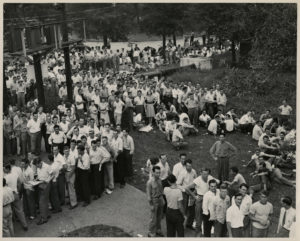The first two buildings on the University of Houston campus—the Roy Gustav Cullen Memorial Building and the Science Building—stood in solitary splendor in the early 1940s, at the epicenter of what became, six decades later, a 667-acre campus serving 40,000 students in over ninety buildings and facilities. Local businessmen, and Houstonians like the Cullen, Settegast, and Taub families, to name a few, played an instrumental role in the school’s early development. By 1942, two new buildings, funded in part by New Deal programs, joined the original structures, providing space to train local navy reserves and recruits through the U.S. Navy Reserve Vocational School. These young men experienced a taste of university life before joining our forces fighting overseas.
The 1940 Selective Service registration affected 77,177 men in Harris County alone, and since UH enrollment drew largely from commuter students, the University must have felt a tremendous drain. Dr. Walter Kemmerer, administrative assistant to the president at the University, expressed concern about the draft’s impact on future enrollment and the University’s role as a supporter of national and community interests. With both objectives in mind, Kemmerer pursued the Army and Navy Reserve Officer Training Corps (ROTC) units. Eventually three Navy training units and a small Army Air Corps unit occupied campus facilities, boosting enrollment while allowing UH to play an active role in the nation’s war efforts.
To read the full text of this article click here.

Watch the collaboration between Houston Public Media and the Center for Public History as they discuss the 100 years of Houston History, an episodic series featuring the GI Bill’s impact on the University of Houston in Episode 5.


 Follow
Follow